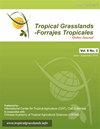Evaluation of cactus pear clones subjected to salt stress
IF 0.7
4区 农林科学
Q3 AGRICULTURE, DAIRY & ANIMAL SCIENCE
引用次数: 2
Abstract
Cactus pear is an important source of fodder for herbivores, though its production is affected by soil salinity. This work aimed to evaluate the development of cactus pear clones subjected to salt stress as a measure of their salinity tolerance. The experimental design was a randomized block with 6 replications. Twenty genotypes of cactus pear were used from the Active Germplasm Bank, with variability in resistance to carmine cochineal [Dactylopius opuntiae (Cockerell)] as this insect species destroys many stands of cactus on farms. One cladode was planted per pot containing 12 kg of sandy soil. Water with a salinity of 3.6 dS/m was applied at 14-day intervals. The clones were scored at 28-day intervals for degree of damage to cladodes (1‒5) and were harvested when they reached a score of 5, showing 100% damage (chlorosis and dehydration) to the whole plant. The Liso Forrageiro clone took 419 days to reach Score 5, indicating its greater tolerance to salinity. Highest dry matter yields were achieved by Orelha de Elefante Mexicana and Orelha de Elefante Africana clones with 51.5 and 50.8 g/plant, respectively, while Liso Forrageiro yielded only 36.1 g/plant, despite having similar surface area and weight of roots to these 2 clones. Further studies in the field involving these better-performing clones seem warranted to determine how the pot trial results are repeated in the field, especially in areas where carmine cochineal insect is prevalent.盐胁迫下仙人掌梨无性系的评价
仙人掌梨是食草动物重要的饲料来源,但其产量受土壤盐分的影响。本研究旨在评价盐胁迫下仙人掌梨无性系的发育情况,以衡量其耐盐性。试验设计为随机区组,设6个重复。从Active种质资源库中选取了20个仙人掌梨基因型,这些基因型对胭脂红虫的抗性存在差异,因为胭脂红虫会破坏农场上的许多仙人掌林。每罐种植一株枝状植物,每罐含有12公斤沙土。每隔14天施用盐度为3.6 dS/m的水。每隔28天对这些无性系枝部(1-5)的损害程度打分,当无性系达到5分时收获,表明整个植株受到100%的损害(黄化和脱水)。Liso Forrageiro无性系花了419天才达到5分,这表明它对盐度的耐受性更强。干物质产量最高的是墨西哥白驴和非洲白驴无性系,分别为51.5 g/株和50.8 g/株,而白驴无性系的干物质产量仅为36.1 g/株,尽管这两个无性系的根系表面积和重量相似。在涉及这些表现较好的无性系的领域进行进一步的研究似乎有必要确定如何在田间重复盆栽试验结果,特别是在胭红胭红虫流行的地区。
本文章由计算机程序翻译,如有差异,请以英文原文为准。
求助全文
约1分钟内获得全文
求助全文
来源期刊

Tropical Grasslands-Forrajes Tropicales
Agricultural and Biological Sciences-Agronomy and Crop Science
CiteScore
1.60
自引率
0.00%
发文量
36
审稿时长
16 weeks
期刊介绍:
The Journal publishes, in English or Spanish, Research Papers and Short Communications on research and development, as well as contributions from practitioners (Farmer Contributions) and Review Articles, related to pastures and forages in the tropics and subtropics. There is no regional focus; the information published should be of interest to a wide readership, encomprising researchers, academics, students, technicians, development workers and farmers.
In general, the focus of the Journal is more on sown (''improved'') pastures and forages than on rangeland-specific aspects of natural grasslands, but exceptions are possible (e.g. when a submission is relevant for a particularly broad readership in the pasture and forage science community).
The Journal will also consider the occasional publication of associated, but closely related, research in the form of an additional scientific communication platform [e.g. a re-make of the former Genetic Resources Communication series of the former Division of Tropical Crops and Pastures of the Commonwealth Scientific and Industrial Research Organisation (CSIRO), Australia].
Areas of particular interest to the Journal are:
Forage Genetic Resources and Livestock Production[...]
Environmental Functions of Forages[...]
Socio-economic Aspects[...]
Topics within the aforementioned areas may include: Diversity evaluation; Agronomy; Establishment (including fertilization); Management and utilization; Animal production; Nutritive value; Biotic stresses (pests and diseases, weeds); Abiotic stresses (soil fertility, water, temperature); Genetics and breeding; Biogeography and germplasm collections; Seed production; Ecology; Physiology; Rhizobiology (including BNF, BNI, mycorrhizae); Forage conservation; Economics; Multilocational experimentation; Modelling.
 求助内容:
求助内容: 应助结果提醒方式:
应助结果提醒方式:


